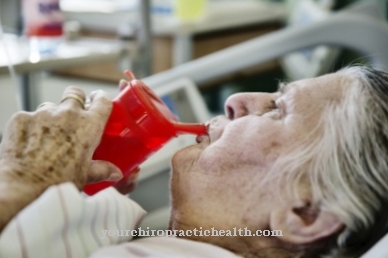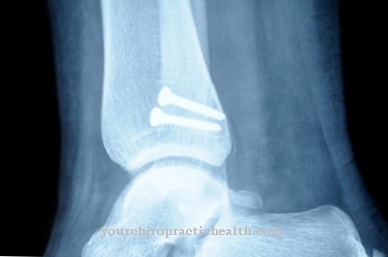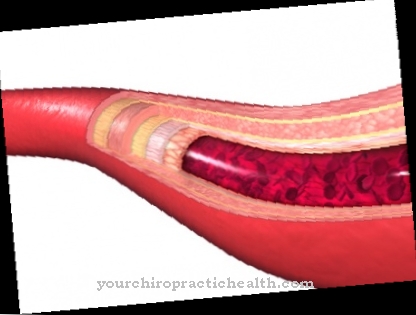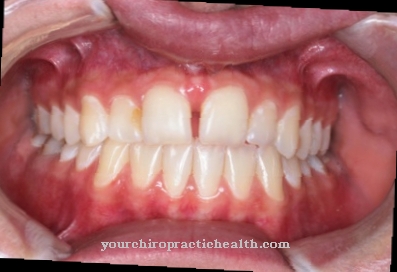With the term Orthostatic response (orthostatic adjustment) defines the ability of the organism to equalize blood pressure when changing to an upright position. This effect can occur, for example, when a person suddenly moves from a lying to a sitting or standing position.
What is the Orthostasis Response?
The extreme change in position of the body poses an extraordinary challenge for the circulatory system, because the return flow of venous blood to the heart is greatly reduced.
Before this, the leg veins expand noticeably due to the increase in hydrostatic pressure. About half a liter of blood can accumulate there due to the abrupt changes in pressure. The orthostatic response can compensate for this.
Function & task

In order to keep the circulation stable in almost every body position and to balance it after a change of position, many body processes take place at the same time. For example, the stroke volume of the heart decreases significantly, in drastic cases by 40 percent. This in turn leads to an increase in heart rate of around 30 percent. A state of collapse is thus reached.
Even in less severe cases there is a very rapid drop in blood pressure. It falls directly due to the sudden change in position from lying to sitting or standing and also indirectly due to the reduction in cardiac output.
This situation is compensated for with the help of the so-called pressoreceptor reflex (also known as the baroreceptor reflex). This stimulates the sympathetic nervous system of the autonomic nervous system. The receptors in the leg veins increase the sympathetic tone, which is why the venous return to the heart increases again. This means that the drop in blood pressure can also be quickly compensated for. This is supported by the temporary slight decrease in kidney blood flow.
Illnesses & ailments
If the orthostasis reaction does not work, it is referred to as orthostatic dysregulation. People affected by this may even become unconscious for a short time in severe cases when quickly changing to an upright posture from a lying position.
This condition results from an insufficient supply of blood and therefore oxygen to the brain. The consequence can be an orthostatic collapse - instantaneous falling over.
At the same time, however, the problem is solved, because in the lying state the circulatory conditions will quickly stabilize again by themselves. The impaired orthostasis mechanism may have less severe consequences such as ringing in the ears and dizziness.
People with chronically low blood pressure are often affected by the complete absence of the orthostatic reaction. This includes mostly young, slim women and adolescents who are in particular growth phases. One reason for this deficiency can be the incorrectly working venous pump, which can lead to larger amounts of blood sinking into the legs.
Anyone who has such a tendency towards incorrect orthostatic reactions can initially help themselves with very simple means. First and foremost, the slow, not hasty straightening up into the vertical leads to improvement. A stronger coffee and an ample supply of fresh, cold air often help.
The inadequate orthostatic adjustment can also make itself felt through too long sunbathing, latent fatigue, lengthy bed rest or the consumption of a cigarette after a long period of abstinence. Then it is often accompanied by a feeling of emptiness in the head, strong heart palpitations, 'stars' in front of the eyes and slight tremors. These more or less harmless symptoms can occasionally occur in completely healthy people.
If the wrong reaction in question appears very often or even constantly, then it is orthostatic hypotension, the chronic drop in blood pressure when the body is straightened up. This disease often occurs with increasing age. In people over 65, it occurs in almost 30 percent of cases. However, only every ninth person affected reports typical symptoms.
According to specific measurements, orthostatic hypotension can be assumed if the systolic blood pressure falls by at least 20 mmHg and the diastolic blood pressure by at least 10 mmHg within one minute.
However, such a drop in blood pressure could lead to a considerable risk of death, for example in patients with cardiovascular diseases who may already have had a heart attack.
Elderly people who suffer from hypotension (drop in blood pressure) are also extremely prone to stroke. In addition, the risk of dementia increases for them. Elderly people are also susceptible to the related clinical picture of postprandial hypotension. With them, the malfunctions take place against the background of increased blood pressure. In this case, the blood sagging in the legs does not have to be the cause of the complaints, but they often occur in the course of digestion after a large meal.
This special form is no less dangerous for older people. The sharp drop in blood pressure about two hours after a meal often affects people with Parkinson's or diabetes mellitus. The medication they take often increases the unpleasant effects of postprandial hypotension considerably.
Slow elevation and great caution when moving too fast are particularly advisable to these affected persons. This is particularly important when you get up in the morning. It is advisable to sit on the edge of the bed a little longer and only get up later. Getting up from the toilet is also better done slowly, especially at night.
Small training units are also helpful, such as the repeated alternating lifting of the feet before straightening up the whole body. As far as possible, long, motionless standing should be avoided and prolonged exposure to extreme heat. It is important to drink enough every day, especially with meals. At least one hour before going to bed, the fluid intake should be reduced or stopped in order to avoid frequent visits to the toilet at night.



























